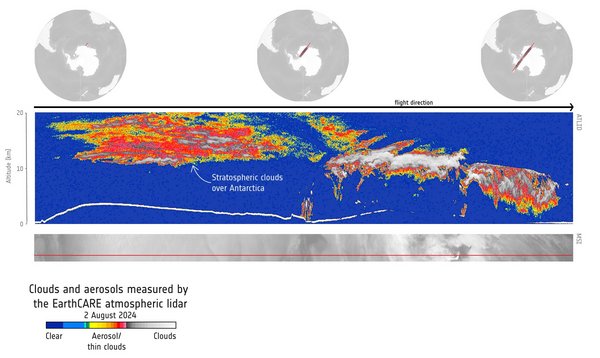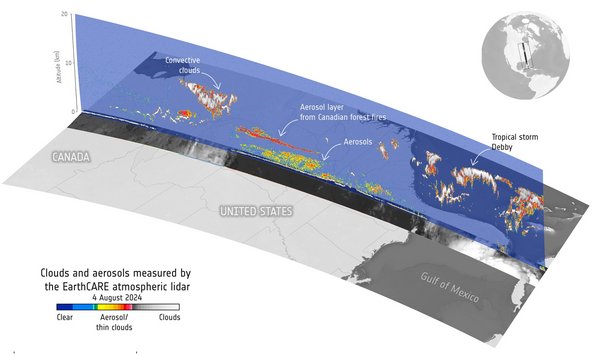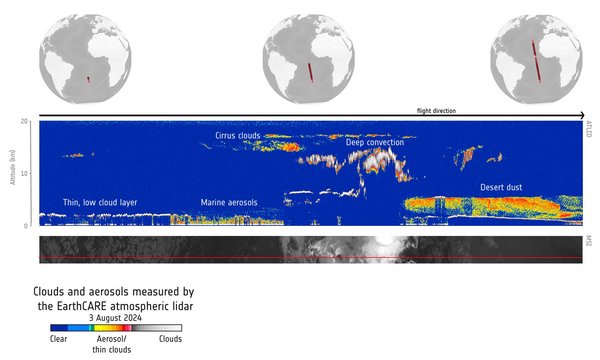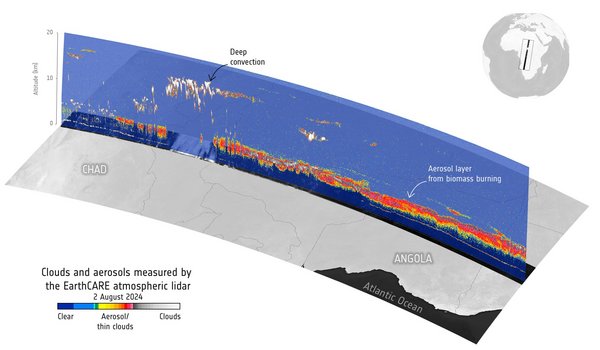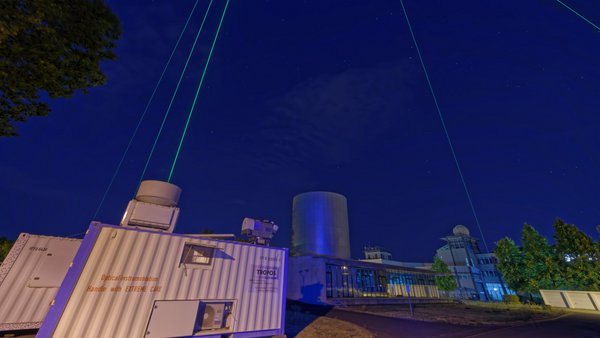EarthCARE's lidar shows particles in the atmosphere in detail
Frascati/Leipzig,
16.09.2024
Fourth instrument of the new climate satellite in operation. Major European measurement campaign atmo4ACTRIS launched.
Frascati/Leipzig. The atmospheric lidar ATLID, the last of four instruments on board the EarthCARE satellite launched in May, has now been successfully put into operation. The joint mission of the European Space Agency (ESA) and the Japanese Space Agency (JAXA) is designed to measure clouds, aerosols and radiation more accurately than ever before. Researchers from the Leibniz Institute for Tropospheric Research (TROPOS) are making an important contribution by developing algorithms that derive the aerosol and cloud stratification from measurements made by the instrument. A large-scale measurement campaign involving around 50 ground stations from the European ACTRIS network, coordinated by TROPOS in Leipzig, is also contributing to the precision of the new climate satellite.
Atmospheric lidar completes the new climate satellite
Equipped with four state-of-the-art instruments - a cloud profiling radar, an atmospheric lidar, a broadband radiometer and a multispectral imager - EarthCARE (Earth Cloud Aerosol and Radiation Explorer) will carry out a number of different measurements simultaneously. Together, these measurements will help to better understand how clouds and aerosols reflect incoming solar energy back into space and how they trap thermal radiation emitted by the Earth. This information is important for understanding how climate change affects the Earth's energy balance and for predicting how quickly clouds and aerosols might lose their current cooling effect in the future.
EarthCARE was launched into orbit around the Earth on 29 May 2024. Just one month later, the satellite delivered the first images from its cloud profiling radar, followed shortly afterwards by the first images from its broadband radiometer, the multispectral imager and, finally, the atmospheric lidar in August. This state-of-the-art instrument records detailed vertical profiles of aerosols and clouds in the atmosphere over different regions of the Earth. Aerosols are tiny particles and droplets from natural sources such as dust and sea salt, and from human activities such as industrial emissions or wood burning. The laser emits short pulses of ultraviolet light, which are reflected by atmospheric targets and analysed in a highly sensitive receiver. The distance can be determined from the transit time, the concentration from the signal strength and the type of aerosol from the polarisation. This makes it possible to measure the distribution and properties of aerosols and clouds, including their height, thickness, optical and physical properties. Synergy with the other three instruments on the satellite is crucial to understanding the role of aerosols and clouds in the Earth's energy balance. A new aerosol classification model ("Hybrid End-to-End Aerosol Classification", or HETEAC for short) has been specially developed as the basis for aerosol typing to ensure that these calculations work across the different instruments. The ATLID atmospheric lidar, in particular, will also make an important contribution to improving air quality forecasts. Ulla Wandinger, who has been involved in the development of ATLID for many years, is delighted with the first measurements: "The wealth of data and the detailed insight into the structures of the atmosphere are absolutely impressive." EarthCARE has the potential to significantly advance the understanding of aerosols, clouds and their interactions, as well as climate research.
The first images from August show the diversity of aerosols and clouds in the Earth's atmosphere: for example, a profile of Polar Stratospheric Clouds (PSC) over Antarctica, which play an important role in the formation of ozone holes, or Tropical Storm Debby over the Gulf of Mexico, and plumes of smoke from forest fires in Canada. Simonetta Cheli, ESA's Director of Earth Observation Programmes, said: “Following on from the first images from EarthCARE’s other three instruments, we can now also see how well the atmospheric lidar is working. These profiles from the atmospheric lidar come exactly as we had anticipated, after the instrument has been through its routine decontamination and calibration processes. The atmospheric lidar brings us completely new insight into the vertical distribution of clouds and aerosols and, together with the other instruments, puts us on course to gaining new scientific understanding into Earth’s energy balance.”
Extensive measurement campaigns in the Atlantic and in Europe
To ensure that the data from the new instruments can be used and interpreted in the best possible way, it is important to compare them with ground-based and airborne measurements in a wide range of situations. For this reason, a series of complex international measurement campaigns are currently underway.
Until November, the German research aircraft HALO will fly under the EarthCARE track several times from Cabo Verde in the Atlantic, from Barbados in the Caribbean and from Oberpfaffenhofen in Germany until November. The HALO-PERCUSION validation mission is led by the German Aerospace Center (DLR) together with the Max Planck Institute for Meteorology (MPI-M). A number of partners, including the University of Leipzig, are also involved. PERCUSION is one of several subprojects of the ORCESTRA (Organised Convection and EarthCare Studies over the Tropical Atlantic) research project coordinated by the MPI-M. Another sub-project is CLARINET (CLoud and Aerosol Remote sensing for EarThcare), in which TROPOS researchers use the new ACTRIS remote sensing station of the Cabo Verde Atmospheric Observatory (CVAO) at the Ocean Science Centre in Mindelo (OSCM) to validate EarthCARE data in the tropical Atlantic and compare them with long-term measurements.
The ground stations of the European research infrastructure ACTRIS play an important role in calibrating the data from the EarthCARE satellite: they have been established and expanded in recent years to analyse aerosol particles and clouds using remote sensing instruments such as lidar and radar. Around 50 stations in Europe and overseas are involved in the atmo4ACTRIS measurement campaign. This dense network offers the great advantage that EarthCARE flies over at least one of the stations practically every day, as the low-Earth orbit ensures that the satellite "flies” over our planet in strips, only returning to the same part of the Earth every 25 days. A single ground station is therefore not sufficient for calibration. "As part of the ATMO-ACCESS infrastructure project, we rehearsed the measurement campaign for two months at the end of last year with simulated overflights to prepare ourselves for the complex task. This was very helpful, because although the ACTRIS stations all work according to the same standards, some of them have very different backgrounds when it comes to validating satellite data. We are all looking forward to comparing the first EarthCARE data with the ground-based measurements," says Dr Holger Baars of TROPOS, who is coordinating the campaign from Leipzig. In addition to the TROPOS stations in Leipzig and Melpitz, stations of the German Weather Service (DWD) in Hohenpeißenberg and Lindenberg, the University of Cologne (UoC) in cooperation with the Jülich Research Centre (FZJ), the Karlsruhe Institute of Technology (KIT) and the University of Leipzig will participate. German partners are also providing important data from overseas: the Alfred Wegener Institute, Helmholtz Centre for Polar and Marine Research (AWI) is contributing observations from Ny-Ålesund in the Arctic in cooperation with the UoC, and TROPOS is providing data from three stations in the Earth's dust belt: Cabo Verde in the Atlantic, Limassol in Cyprus and Dushanbe in Tajikistan.
This activity has received funding from the European Union’s Horizon 2020 research and innovation programme through the ATMO-ACCESS Integrating Activity under grant agreement No 101008004.
Source:
ESA (EarthCARE profiles atmospheric particles in detail, 21/08/2024)
https://www.esa.int/Applications/Observing_the_Earth/FutureEO/EarthCARE/EarthCARE_profiles_atmospheric_particles_in_detail
Contacts for the media:
Atmospheric lidar ATLID:
Dr Ulla Wandinger
Department of Remote Sensing of Atmospheric Processes, Leibniz Institute for Tropospheric Research (TROPOS), Leipzig
Phone: +49-341-2717-7082
https://www.tropos.de/en/institute/about-us/employees/ulla-wandinger
and
Dr Athina Augusta Floutsi
Department of Remote Sensing of Atmospheric Processes, Leibniz Institute for Tropospheric Research (TROPOS), Leipzig
Phone +49-341-2717-7387
https://www.tropos.de/en/institute/about-us/employees/athina-floutsi
and
Dr Moritz Haarig
Department of Remote Sensing of Atmospheric Processes, Leibniz Institute for Tropospheric Research (TROPOS), Leipzig
Phone +49-341-2717-7188
https://www.tropos.de/en/institute/about-us/employees/moritz-haarig
Measurement campaigns atmo4ACTRIS & ORCESTRA-CLARINET:
Dr Holger Baars
Department of Remote Sensing of Atmospheric Processes, Leibniz Institute for Tropospheric Research (TROPOS), Leipzig
Phone +49-341-2717-7314
https://www.tropos.de/en/institute/about-us/employees/holger-baars
or
Tilo Arnhold, TROPOS Public Relations
Phone +49 341 2717-7189
https://www.tropos.de/en/current-issues/press-releases
Further information and links:
EarthCARE - ESA's cloud and aerosol mission: https://www.esa.int/Applications/Observing_the_Earth/FutureEO/EarthCARE
EarthCARE Information: https://earth.esa.int/eogateway/missions/earthcare
EarthCARE images: https://www.esa.int/ESA_Multimedia/Missions/EarthCARE/(result_type)/images
EarthCARE Videos: https://www.esa.int/ESA_Multimedia/Missions/EarthCARE/(result_type)/videos
Important software for the new European-Japanese Earth observation satellite EarthCARE. TROPOS researchers develop processors to measure clouds and aerosols (TROPOS, 23 May 2024):
https://www.tropos.de/aktuelles/pressemitteilungen/details/wichtige-software-fuer-den-neuen-europaeisch-japanischen-erdbeobachtungssatelliten-earthcare
On the trail of interactions in the Earth's atmosphere (DLR, 1 February 2024): https://www.dlr.de/de/aktuelles/nachrichten/2024/den-wechselwirkungen-in-der-erdatmosphaere-auf-der-spur
German EarthCARE project office: https://earthcare-mission.de/
EarthCARE Mission Validation, Featuring a 2-Month Rehearsal Campaign: https://www.actris.eu/EarthCARE%20Mission%20Validation
HALO mission PERCUSION:
https://halo-research.de/sience/future-missions/ec-tooc/
https://orcestra-campaign.org/intro.html
TROPOS- Studies on the technical realisation of future satellite missions:
EarthCARE - Earth Clouds, Aerosols and Radiation Explorer: https://www.tropos.de/forschung/grossprojekte-infrastruktur-technologie/technologie-am-tropos/algorithmenentwicklung/studien-zur-technischen-umsetzung-zukuenftiger-satellitenmissionen
Last experiments of the Aeolus satellite for TROPOS before re-entry into the Earth's atmosphere (TROPOS, 28 July 2023): https://www.tropos.de/aktuelles/pressemitteilungen/details/letzte-experimente-des-aeolus-satelliten-fuer-tropos-vor-wiedereintritt-in-die-erdatmosphaere
Major measurement campaign in the Atlantic begins (TROPOS, 30 June 2021): https://www.tropos.de/aktuelles/pressemitteilungen/details/grosse-messkampagne-im-atlantik-laeuft-an
Laser expertise from Germany supports new ESA wind satellite (TROPOS, 21.08.2018): https://www.tropos.de/aktuelles/pressemitteilungen/details/laser-knowhow-aus-deutschland-unterstuetzt-neuen-esa-windsatelliten
European validation campaign within the framework of ACTRIS and ATMO ACCESS:
https://www.actris.eu/EarthCARE%20Mission%20Validation
The Leibniz Institute for Tropospheric Research (TROPOS) is a member of the Leibniz Association, which unites 96 independent research institutions. Their focus ranges from the natural, engineering and environmental sciences to economics, spatial and social sciences and the humanities. Leibniz Institutes are dedicated to socially, economically and ecologically relevant issues.
They conduct knowledge- and application-oriented research, including in the overarching Leibniz Research Alliances, are or maintain scientific infrastructures and offer research-based services. The Leibniz Association focuses on knowledge transfer, especially with the Leibniz Research Museums. It advises and informs politics, science, business and the public.
Leibniz institutions maintain close cooperation with universities - including in the form of the Leibniz ScienceCampi, with industry and other partners in Germany and abroad. They are subject to a transparent and independent review process. Due to their national importance, the federal and state governments jointly fund the institutes of the Leibniz Association. The Leibniz Institutes employ around 20,500 people, including 11,500 scientists.
The total budget of the institutes is 2 billion euros. They are jointly financed by the federal and state governments. The basic funding of the Leibniz Institute for Tropospheric Research (TROPOS) is provided by the Federal Ministry of Education and Research (BMBF) and the Saxon State Ministry of Science and the Arts (SMWK). The institute is co-financed by tax revenue on the basis of the budget approved by the Saxon State Parliament.
http://www.leibniz-gemeinschaft.de
https://www.bmbf.de/
https://www.smwk.sachsen.de/
